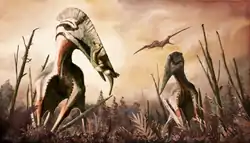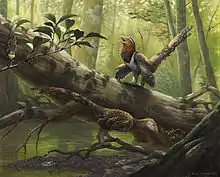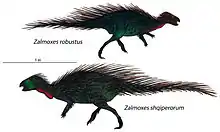Hațeg Island
Hațeg Island was a large offshore island in the Tethys Sea which existed during the Late Cretaceous period, probably from the Cenomanian to the Maastrichtian ages.[1] It was situated in an area corresponding to the region around modern-day Hațeg, Hunedoara County, Romania.[2] Maastrichtian fossils of small-sized dinosaurs have been found in the island's rocks.[3] It was formed mainly by tectonic uplift during the early Alpine orogeny, caused by the collision of the African and Eurasian plates towards the end of the Cretaceous.[4] There is no real present-day analog, but overall, the island of Hainan (off the coast of China) is perhaps closest as regards climate, geology and topography, though still not a particularly good match. The vegetation, for example, was of course entirely distinct from today, as was the fauna.

The Hungarian paleontologist Franz Nopcsa theorized that "limited resources" found on the island commonly have an effect of "reducing the size of animals" over the generations, producing a localized form of dwarfism. Nopcsa's theory of insular dwarfism—also known as the island rule—is today widely accepted.
Geography
While a variety of estimates regarding the prehistoric island's size have been given over the years, the most reliable estimate places it at roughly 80,000 square kilometers during the Maastrichtian, or about the size of the modern island of Hispaniola. It was positioned just within the equatorial belt, at about 27°N latitude.[1]
Haţeg Island was probably located at least 200 kilometres (120 mi) from the nearest land mass. To the northwest was an island corresponding to the Bohemian Massif, to the southeast was an island corresponding to the Balkan–Rhodope Massif (including the modern Rhodope Mountains region), and to the west was a large island corresponding to part of the modern Iberian land mass. The closest continental land mass were portions of the Austro-Alpine region to the west and the Adriatic region to the south.[1]
Haţeg Island itself was surrounded primarily by a deep marine basin, unlike some of the surrounding islands and land masses which were surrounded by shallow seas.[1]
Climate and ecology
During the Maastrichtian, the climate of Haţeg Island was sub-tropical, with an average temperature of 20-25 degrees Celsius.[1] The island experience marked rainy and dry seasons, but despite this, the plant life on the island was mainly tropical in nature. Carbon isotopes indicate "dry woodland" conditions. This seeming contradiction between the seasonally dry climate and tropical plant species can be explained by the fact that tropical plants can thrive in a seasonally monsoonal environment today as long as they have access to sufficient amounts of water year-round, and the Haţeg environment seems to have been dominated by braided rivers and lakes. Early rock layers are dominated by volcanic deposits, but these are absent in higher layers, indicating that volcanic activity dropped off during this time.[1]
Paleofauna



About nine species of dinosaurs, and several species of pterosaur are thought to have been indigenous to the island. Most of these animals were smaller versions of mainland megafauna, which became smaller due to island dwarfism, although this is certainly not the case for Hatzegopteryx which, being one of the biggest pterosaurs ever, is an example of island gigantism. Mammals are almost exclusively represented by the endemic kogaionid multituberculates, an endemic group that evolved in the island's isolation and developed unique insectivorous habits,[5] as well as a single eutherian remain.[6]
Among these animals are included:
- Allodaposuchus precedens, an eusuchian
- Sabresuchus sympiestodon, a paralligatorid
- Barbatodon, a genus of multituberculate represented by at least three species
- Kogaionon ungureanui, a multituberculate
- Litovoi tholocephalos, a dome-headed multituberculate
- Hatzegopteryx thambema, an azhdarchid
- Rhabdodon priscus, a rhabdodontid
- Zalmoxes robustus, a rhabdodontid
- Telmatosaurus transylvanicus, a hadrosaur
- Struthiosaurus transylvanicus, a struthiosaurine nodosaur
- Magyarosaurus dacus, a titanosaur (either a saltasaurid or a nemegtosaurid)
- Paludititan nalatzensis, a titanosaur
- Elopteryx nopcsai, an elopterygine troodont
- "Megalosaurus hungaricus", an indeterminate theropod
- Balaur bondoc, originally described as a dromeosaurid but now believed to be an early example of insular flightless bird
- Bradycneme draculae, an alvarezsaurid
- Eurazhdarcho langendorfensis, an azhdarchid
- Albadraco tharmisensis, an azhdarchid
- A new recently found species of azhdarchid is also found, but has no name yet.
- Aprosuchus ghirai-a late surviving atoposaurid crocodyliform
Constituent Formations
The Hațeg Island record is preserved as a number of formations, dating from the late Campanian to the Maastrichtian. These include:
- Sânpetru Formation
- Densus Ciula Formation
- Sebeş Formation
- Sard Formation
- Jibou Formation
References
- Benton, M.J., Csiki, Z., Grigorescu, D., Redelstorff, R., Sander, P.M., Stein, K., and Weishampel, D.B. (2010). "Dinosaurs and the island rule: The dwarfed dinosaurs from Haţeg Island. Archived 2011-07-10 at the Wayback Machine" Palaeogeography, Palaeoclimatology, Palaeoecology, 293(3-4): 438–454.
- Csikia, Z.; M. J. Bentonb (2010). "An island of dwarfs — Reconstructing the Late Cretaceous Hațeg palaeoecosystem". Palaeogeography, Palaeoclimatology, Palaeoecology. 293 (3–4): 265–270. doi:10.1016/j.palaeo.2010.05.032.
- Grigorescu, D. (2005). "Rediscovery of a 'forgotten land': The last three decades of research on the dinosaur-bearing deposits from the Hațeg Basin". Acta Palaeontologica Romaniae. 5: 191–204.
- Tom Baird and Richard Conium. "Geology of Haţeg". Paleobiology and Biodiversity Research Group, Department of Earth Sciences, University of Bristol. Retrieved March 16, 2020.
It was formed by uplift caused by the closing of the Tethys Ocean by the collision of the African and Eurasian plates
- Thierry Smith, Codrea Vlad, Red Iron-Pigmented Tooth Enamel in a Multituberculate Mammal from the Late Cretaceous Transylvanian " Haţeg Island ", Article in PLoS ONE 10(7):e0132550-1-16 · July 2015 DOI: 10.1371/journal.pone.0132550
- Codrea, Vlad; Smith, Thierry; Dica, Paul; Folie, Annelise; Garcia, Géraldine; Godefroit, Pascal; Van Itterbeeck, Jimmy (2002). "Dinosaur egg nests, mammals and other vertebrates from a new Maastrichtian site of the Haţeg Basin (Romania)". Comptes Rendus Palevol. 1 (3): 173–180. doi:10.1016/S1631-0683(02)00021-0. ISSN 1631-0683.
External links
| Wikimedia Commons has media related to Hațeg Island. |